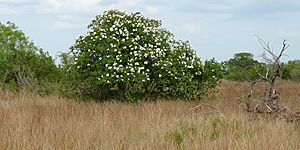Anacahuita facts for kids
Quick facts for kids Anacahuita |
|
|---|---|
| Scientific classification | |
| Genus: |
Cordia
|
| Species: |
boissieri
|
 |
|
| Natural range | |
Cordia boissieri is a beautiful plant often called the Mexican olive or anacahuita. It's a type of flowering shrub or small tree. You can find it growing naturally from southern Texas in the United States all the way down to central Mexico. It belongs to the borage family, which is called Boraginaceae. This plant was named after a botanist named Pierre Edmond Boissier. Other common names for it include white cordia and Texas wild olive.
Contents
What Does the Mexican Olive Look Like?
The Mexican olive tree can grow to be about 5 to 7 meters (16 to 23 feet) tall. It has a nice round shape at the top, which is about 3 to 5 meters (10 to 16 feet) wide. Its leaves are shaped like an oval and are about 9 to 18 centimeters (3.5 to 7 inches) long. They are also about 5 to 9 centimeters (2 to 3.5 inches) wide.
This tree is an evergreen, meaning it usually keeps its leaves all year. However, if it gets too cold and frosty, it might lose some leaves. The flowers are white and shaped like a funnel. They are about 3 to 5 centimeters (1 to 2 inches) across. You can see these pretty flowers on the tree throughout the whole year.
The fruits of the Mexican olive are called drupes. They look a bit like small, yellow-green olives. Each fruit is about 1.2 to 2.4 centimeters (0.5 to 1 inch) long. While they taste sweet, they can make people feel dizzy if eaten fresh. The tree usually lives for about 30 to 50 years.
How People Use the Mexican Olive
People have found many uses for the Mexican olive tree.
- Food: Jellies made from the fruits are safe to eat and are quite tasty.
- Medicine: A syrup made from the fruits can be used to help with coughs. The leaves are also used in some traditional remedies. They can help with joint pain and lung problems.
- Dye: The syrup from the fruits can also be used to dye cloth. This gives fabric a unique color.
- Wood: The wood from the tree is useful too. It can be burned as firewood to keep warm. It's also used for carpentry, which means making things out of wood.
- Gardens: Many people plant the Mexican olive as an ornamental plant. This means they grow it because it looks nice. It's popular for its compact size and its beautiful, showy flowers. It can grow well in areas with mild winters, specifically in USDA Zone 9a.
Mexican Olive in Nature
The Mexican olive tree plays an important role in its environment. It is a "host plant" for a special insect called the wild olive tortoise beetle (Physonota alutacea). This means the beetle lives on the tree and gets its food from it.
Symbolism
The anacahuita, or Mexican olive, is very special in Mexico. It is the official flower of the state of Nuevo León. This shows how important and recognized this beautiful plant is in that region.
See also
 In Spanish: Anacagüita para niños
In Spanish: Anacagüita para niños


